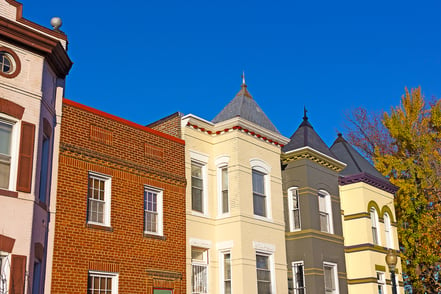Among the historic brick homes in DC's neighborhoods are some vintage brick apartment buildings. Property managers of these old structures seek cost-effective ways to carry out needed repairs while carefully preserving the historical dignity of their buildings. When the brick facades begin to deteriorate, owners and managers want to attract future renters with restorations that preserve the beauty of their rich history.
Tuckpointing Historic DC Brick Buildings
Tuckpointing—or “repointing,”—describes the restoration of historic brick buildings by removing mortar between masonry joints and replacing it with lime-based mortar. This term applies to restoration work on both building facades and chimneys.
Lime, a stone used in construction for centuries, is the core ingredient in historic mortar. Its composition, texture, and strength/level of "hardness" are entirely different from cement or concrete, which are modern building materials suited for new construction.
If a historic building is repointed with cement, the material's extreme density - its level of hardness - will cause the softer coal-fired bricks to crack. If a historic building is not appropriately tuckpointed, it will eventually show signs of structural damage and interior water penetration.
Guidelines for Brick Restoration DC
Successful property managers who oversee maintenance and repair should be familiar with the process of brick restoration. There is a recommended method for tuckpointing historic brick buildings based on extensive research, physical/scientific evidence, and hands-on experience working with the structures themselves:
- Historic structures should be repointed in their entirety, not in sections here and there as in spot tuckpointing; a comprehensive plan for the repair of exterior walls will ensure that all issues—including but not limited to gaps in the mortar, harmful cement repairs, and failing/uneven brick courses--are addressed and rectified in a timely manner.
- The work should be completed by a highly skilled crew of trained masons; even a small DC row house requires a minimum team of three, as this job is complicated and must be carefully organized and executed from both on the scaffolding and on the ground.
- All mortar joints—whether untouched or filled with cement—must be scraped out by hand. Some joints will need to be opened to a depth of as many as three inches to ensure that the new mortar bonds correctly with the existing mortar deep inside the wall.
- Lime mortar must be used to tuckpoint a historic building. Many contractors and some historic preservation agencies advocate the use of Type N or Type O mortar. These mixes consist mostly of lime. They are also inexpensive, easy to mix, and readily available. They do, however, contain a small percentage of cement. Lime mortar containing no cement is by far the best option for historic structures.
- Restored mortar joints should be struck with a tool creating a slight concave recess in the joint to prevent water penetration and staining on the brick wall.
- A newly tuckpointed wall should be cleaned thoroughly with a diluted acid solution or a specially formulated masonry cleaner to remove dirt, staining, and any residual mortar left on the brick faces during the work.
Masonry Contractors Washington DC
After decades of exposure, the mortar joints between the bricks on historic buildings begin to fail. Because of the era in which so many structures were built in Washington DC, brick restoration in these historic buildings should be trusted to masonry contractors who are specialists in the correct application of traditional materials and methods.
Renaissance Development, a leader in brick restoration and historic preservation, specializes in the restoration of a historic brick building’s mortar joints using traditional methods (tuckpointing) and materials. Contact us for a free site visit and project quote.
Apr 25, 2019 8:30:00 AM



